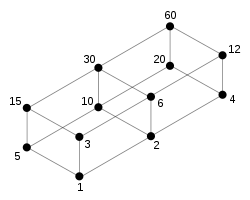Aliquot sequence
In mathematics, an aliquot sequence is a recursive sequence in which each term is the sum of the proper divisors of the previous term. The aliquot sequence starting with a positive integer k can be defined formally in terms of the sum-of-divisors function σ1 in the following way:[1]
- s0 = k
- sn = σ1(sn−1) − sn−1.
For example, the aliquot sequence of 10 is 10, 8, 7, 1, 0 because:
- σ1(10) − 10 = 5 + 2 + 1 = 8
- σ1(8) − 8 = 4 + 2 + 1 = 7
- σ1(7) − 7 = 1
- σ1(1) − 1 = 0
Many aliquot sequences terminate at zero (sequence A080907 in OEIS); all such sequences necessarily end with a prime number followed by 1 (since the only proper divisor of a prime is 1), followed by 0 (since 1 has no proper divisors). There are a variety of ways in which an aliquot sequence might not terminate:
- A perfect number has a repeating aliquot sequence of period 1. The aliquot sequence of 6, for example, is 6, 6, 6, 6, ...
- An amicable number has a repeating aliquot sequence of period 2. For instance, the aliquot sequence of 220 is 220, 284, 220, 284, ...
- A sociable number has a repeating aliquot sequence of period 3 or greater. (Sometimes the term sociable number is used to encompass amicable numbers as well.) For instance, the aliquot sequence of 1264460 is 1264460, 1547860, 1727636, 1305184, 1264460, ...
- Some numbers have an aliquot sequence which is eventually periodic, but the number itself is not perfect, amicable, or sociable. For instance, the aliquot sequence of 95 is 95, 25, 6, 6, 6, 6, ... . Numbers like 95 that are not perfect, but have an eventually repeating aliquot sequence of period 1 are called aspiring numbers (
 A063769).
A063769).
The lengths of the Aliquot sequences that start at n are
- 1, 2, 2, 3, 2, 1, 2, 3, 4, 4, 2, 7, 2, 5, 5, 6, 2, 4, 2, 7, 3, 6, 2, 5, 1, 7, 3, 1, 2, 15, 2, 3, 6, 8, 3, 4, 2, 7, 3, 4, 2, 14, 2, 5, 7, 8, 2, 6, 4, 3, ... (sequence A044050 in OEIS)
The final terms (excluding 1) of the Aliquot sequences that start at n are
- 1, 2, 3, 3, 5, 6, 7, 7, 3, 7, 11, 3, 13, 7, 3, 3, 17, 11, 19, 7, 11, 7, 23, 17, 6, 3, 13, 28, 29, 3, 31, 31, 3, 7, 13, 17, 37, 7, 17, 43, 41, 3, 43, 43, 3, 3, 47, 41, 7, 43, ... (sequence A115350 in OEIS)
Numbers whose Aliquot sequence terminates in 1 are
- 1, 2, 3, 4, 5, 7, 8, 9, 10, 11, 12, 13, 14, 15, 16, 17, 18, 19, 20, 21, 22, 23, 24, 26, 27, 29, 30, 31, 32, 33, 34, 35, 36, 37, 38, 39, 40, 41, 42, 43, 44, 45, 46, 47, 48, 49, 50, ... (sequence A080907 in OEIS)
Numbers whose Aliquot sequence terminates in a perfect number are
- 25, 95, 119, 143, 417, 445, 565, 608, 650, 652, 675, 685, 783, 790, 909, 913, ... (sequence A063769 in OEIS)
Numbers whose Aliquot sequence terminates in a cycle with length at least 2 are
- 220, 284, 562, 1064, 1184, 1188, 1210, 1308, 1336, 1380, 1420, 1490, 1604, 1690, 1692, 1772, 1816, 1898, 2008, 2122, 2152, 2172, 2362, ... (sequence A121507 in OEIS)
Numbers whose Aliquot sequence is not known to be finite or eventually periodic are
- 276, 306, 396, 552, 564, 660, 696, 780, 828, 888, 966, 996, 1074, 1086, 1098, 1104, 1134, 1218, 1302, 1314, 1320, 1338, 1350, 1356, 1392, 1398, 1410, 1464, 1476, 1488, ... (sequence A131884 in OEIS)
An important conjecture due to Catalan with respect to aliquot sequences is that every aliquot sequence ends in one of the above ways–with a prime number, a perfect number, or a set of amicable or sociable numbers.[2] The alternative would be that a number exists whose aliquot sequence is infinite, yet aperiodic. Any one of the many numbers whose aliquot sequences have not been fully determined might be such a number. The first five candidate numbers are called the Lehmer five (named after Dick Lehmer): 276, 552, 564, 660, and 966.[3]
As of March 2015, there were 898 positive integers less than 100,000 whose aliquot sequences have not been fully determined, and 9193 such integers less than 1,000,000.[4]
External links
- Tables of Aliquot Cycles (J.O.M. Pedersen)
- Aliquot Page (Wolfgang Creyaufmüller)
- Aliquot sequences (Christophe Clavier)
- Forum on calculating aliquot sequences (MersenneForum)
- Aliquot sequence summary page for sequences up to 100000 (there are similar pages for higher ranges) (Karsten Bonath)
- Active research site on aliquot sequences (Jean-Luc Garambois)
Notes
- ↑ Weisstein, Eric W., "Aliquot Sequence", MathWorld.
- ↑ Weisstein, Eric W., "Catalan's Aliquot Sequence Conjecture", MathWorld.
- ↑ Lehmer Five (W. Creyaufmüller)
- ↑ Aliquot Pages (W. Creyaufmüller)
References
- Manuel Benito; Wolfgang Creyaufmüller; Juan Luis Varona; Paul Zimmermann. Aliquot Sequence 3630 Ends After Reaching 100 Digits. Experimental Mathematics, vol. 11, num. 2, Natick, MA, 2002, p. 201-206.
- W. Creyaufmüller. Primzahlfamilien - Das Catalan'sche Problem und die Familien der Primzahlen im Bereich 1 bis 3000 im Detail. Stuttgart 2000 (3rd ed.), 327p.
| ||||||||||||||||||||||||||||
